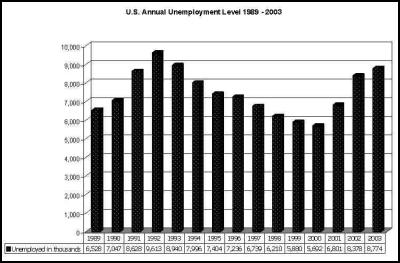U.S. Annual Unemployment - The Bush Effect
U.S. Annual Unemployment - The Bush Effect
By Patricia Johnson
At the end of 1988 the annual unemployment level for the U.S. was 6.7 million [6,701,000].
George H.W. Bush, Sr., became the 41st
President of the United States on January 20, 1989. During
the four years that Bush, Sr., was in office the annual
unemployment level increased each year, and by the time he
left office the level had increased by 2.9 million
to an annual level of 9.6 million.
Year Total
1989 6,528,000
1990 7,047,000
1991 8,628,000
1992 9,613,000
William J. Clinton became the 42nd President of the United States on January 20, 1993. For each of the eight years that Clinton was in office, the level decreased, and by the time he left office the unemployment level had decreased by 3.9 million, to an annual level of 5.7 million.
Year Total
1993 8,940,000
1994 7,996,000
1995 7,404,000
1996 7,236,000
1997 6,739,000
1998 6,210,000
1999 5,880,000
2000 5,692,000
George W. Bush became the 43rd President of the United States on January 20, 2001. In the three years that he has been in office, the annual level has increased each year. Over the three year period, this has amounted to an increase of 3.1 million, as the annual level for 2003 was recorded at 8.8 million.
Year Total
2001 6,801,000
2002 8,378,000
2003 8,774,000

Click for big version
When you chart the data for the 15-year period of time, you have to ask the question – is it poor management skills, poor economic advice, or simply a coincidence that when a Republican becomes President, the annual unemployment level increases each year they are in office?
Every day we here stories about how this indicator, or that indicator shows that the U.S. economy is on fire breaking forecasts left and right, but once again, the true numbers tell a different story.
If the U.S. economy is doing so well, why has the annual unemployment level increased by 3.1 million since this administration took office?


 Eugene Doyle: The Fall Of Saigon 1975 - Fifty Years Of Repeating What Was Forgotten
Eugene Doyle: The Fall Of Saigon 1975 - Fifty Years Of Repeating What Was Forgotten Peter Dunne: Dunne's Weekly - Trump's Tariffs Still Pose Risks For New Zealand
Peter Dunne: Dunne's Weekly - Trump's Tariffs Still Pose Risks For New Zealand Keith Rankin: Barbecued Hamburgers And Churchill's Bestie
Keith Rankin: Barbecued Hamburgers And Churchill's Bestie Gordon Campbell: On Why The US Stands To Lose The Tariff Wars
Gordon Campbell: On Why The US Stands To Lose The Tariff Wars Eugene Doyle: Before It’s Too Late - Reimagine New Zealand’s Military Future
Eugene Doyle: Before It’s Too Late - Reimagine New Zealand’s Military Future  Binoy Kampmark: Gender Stunts In Space - Blue Origin’s Female Celebrity Envoys
Binoy Kampmark: Gender Stunts In Space - Blue Origin’s Female Celebrity Envoys